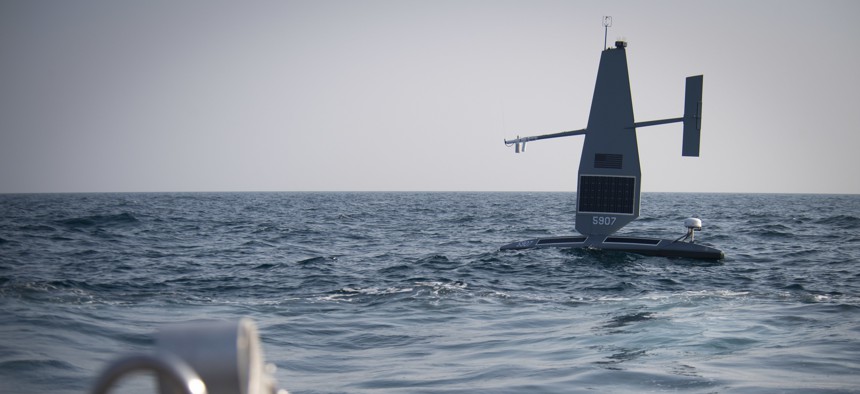
A Saildrone Explorer unmanned surface vessel (USV) operates in the Arabian Gulf during exercise Phantom Scope, Oct. 7. During the bilateral exercise between the United States and United Kingdom, USVs operated in conjunction with crewed ships and naval command centers ashore in Bahrain U.S. Navy photo by Chief Mass Communication Specialist Roland Franklin
The Navy is using robot ships to deter human smuggling out of Haiti
4th Fleet’s experiments with unmanned systems are a “game changer” for monitoring illicit activity, commander says
The U.S. Navy, working with the Coast Guard, has been operating seven surface drones off of the northern coast of Haiti to monitor illegal human smuggling by sea, an increasingly deadly practice that claims hundreds of lives per year.
But the sea drones are doing more than helping the Navy keep watch over the Caribbean, Rear Adm. James Aiken, the commander of U.S. 4th Fleet, told Defense One.
“They actually served as a deterrent, and folks who would actually run a migration ship north—maybe into the United States or somewhere else into the Caribbean—no longer did it, because they realized that they were being watched,” he said.
Aiken made his remarks as part of the State of Defense series.
While every service and geographic combatant command is doing some work with unmanned systems, 4th Fleet, which sails the Caribbean, Central and South America, and surrounding waters, has emerged as a leader in bringing artificial intelligence and robotics into large-scale exercises and operation. Last April, the Navy’s then-leader, Adm. Michael Gilday, singled out 4th Fleet to lead a series of experiments to test new concepts in human and machine teaming at sea.
Part of the thinking at the time, Gilday said, was to test sea and air drones as well as other unmanned systems against threats from China, Russia, and other actors that use non-uniformed or commercial elements for things like smuggling or drug trafficking.
While much has been made of the value of large numbers of small cheap drones for combat operations in places like Ukraine, Aiken said, drones—coupled with advanced AI to synthesize and analyze intelligence footage—has been a “game changer” for monitoring illicit activity.
“Do I see people who are turning on [automatic identification system]? Do I see people who are maybe providing some sort of fuel to some sort of traffic, to either a drug trafficker or a human trafficker? I can use some of the AI tools to gather that type of information and really to get after some of the problems.”
AIken said 4th Fleet isn’t alone in testing out those concepts but the fleet is able to test out new ideas on a bigger scale than other naval components, and bring in partner militaries.
Last July, the fleet hosted its annual Unitas exercise, bringing together some 20 partner nations as well as 26 warships, three submarines, 25 aircraft—approximately 7,000 people.
“We incorporated unmanned surface subsurface and air [systems] into the exercise…We were specific in making it a part of the whole exercise. So when we did the missile shoot…we were able to identify it, track it. We were able to target and then we were also able to provide battle damage assessment.”
As much as those efforts help inform the U.S. military on how to bring robots and AI into their operations, Aiken said, a principal benefit is helping smaller partner navies understand how they can use drones to multiply the impact of their forces.
“The cost of unmanned right now is significantly less than a manned vessel. So there's a lot of value going forward with that, especially with our partners and allies.”
NEXT STORY: What is the Space Force’s new Futures Command?


